大学英语快速阅读课文Wildlife Conservation带翻译 课后习题答案
- 格式:doc
- 大小:26.32 KB
- 文档页数:33
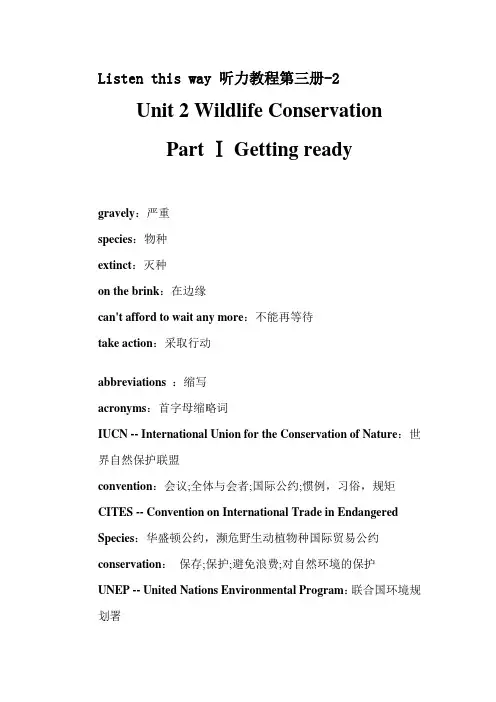
Listen this way 听力教程第三册-2Unit 2 Wildlife ConservationPart Ⅰ Getting readygravely:严重species:物种extinct:灭种on the brink:在边缘can't afford to wait any more:不能再等待take action:采取行动abbreviations :缩写acronyms:首字母缩略词IUCN -- International Union for the Conservation of Nature:世界自然保护联盟convention:会议;全体与会者;国际公约;惯例,习俗,规矩CITES -- Convention on International Trade in Endangered Species:华盛顿公约,濒危野生动植物种国际贸易公约conservation:保存;保护;避免浪费;对自然环境的保护UNEP -- United Nations Environmental Program:联合国环境规划署WWF -- World Wide Fund for Nature :世界自然基金会regulate:调节;控制,管理promote the conservation:促进保护under the auspices of:在…的帮助或支持下;有…赞助的prohibit:禁止endangered species:濒危野生动植物种encourage partnerships in doing sth:鼓励伙伴partnership:伙伴关系;合伙人身份;合作关系;合营公司inspiring information:鼓舞人心的信息improve their quality of life:改善生活品质without compromising:不妥协enable sb to do sth:使……能raise funds for :筹款giant panda:大熊猫a global network:全球网Gland:格兰德Switzerland:瑞士biological diversity:生物多样性ecosystem services:生态系统服务variety:种类a breathable atmosphere:洁净的(能够呼吸的)空气reduce in number :数量减少role:任务negligible:以忽略的;微不足道的apes:猿whales:鲸seals:海豹marine turtles:海龟walrus:海象dolphins:海豚crocodiles:鳄鱼bludgeon:攻击;威胁,强迫campaign:运动sanctuaries:庇护所sea sanctuary:海洋保护区protected-nesting sites :受保护的营巢区nesting site:营巢区;筑巢区;巢址pollute:污染ivory:象牙porpoise:动鼠海豚come into force:开始生效habitat:(动物的)栖息地,住处compromise:妥协roll off:辗轧;下降breed:繁殖public appeal:公众诉求;呼吁slaughter:屠宰(动物);大屠杀make a donation:捐款Wild animals and wild plants and the wild places where they live are gravely threatened almost everywhere. One species has become extinct in each year of this century; and many hundreds are now on the brink. We can't afford to wait any more. It is time that we take action.A The following words and phrases will appear in this unit. Listen carefully and study the definitions.1. habitat: the natural home of a planet or animal2. species: a group of plants or animals of the same kind, which are alike in all important ways and can breed together3. bludgeon: hit with a heavy object4. census: a count of a total population5. logistics: the planning and implementation of the details of any operation6. degrade: bring down7. adversely: in the manner of going against, opposing8. refuge: a place that provides protection or shelter from danger9. aquatic: living in or on water10. mussel: a small sea animal living inside a black shell whose soft body can be eaten as food (淡菜)11. staple food: basic food or main food that one normally eats12. picky eater: someone who is very careful about choosing only what they like to eat13. shrink: to become or cause to become smaller in size14. case study: a detailed analytical study of a person or something with a view to making generalizationsB Listen to some abbreviations and acronyms of some organizations and some information about them. Fill in the blanks.Audioscript:1. IUCN -- International Union for the Conservation of Nature, is the organization established by the United Nations to promote the conservation of wildlife and habitats as part of the national policies of member states.2. CITES -- Convention on International Trade in Endangered Species. is an international agreement under the auspices of the IUCN with the aim of regulating trade in endangered species of animals and plants. The agreement came into force in 1975 and by 1991 had been signed by 110 states. It prohibits any trade in a category of 8,000 highly endangered species and controls trade in a further 30,000 species.3. UNEP -- United Nations Environmental Program, aims to provide leadershi p and encourage partnerships in caring for the environment by inspiring information and enabling nations and people to improve their quality of life without compromising that of future generations.4. WWF -- World Wide Fund for Nature (formerly World Wildlife Fund), is an international organization established in 1961 to raise funds for conservation by public appeal. Projects include conservation of particular species, for example, the tiger and giant panda. With almost five million supporters distributed throughoutfive continents, WWF has a global network active in over 90 countries. Its headquarters are in Gland, Switzerland.Biological diversity provides us with a variety of special "ecosystem services", such as clean water, a breathable atmosphere and natural climate control. However, many kinds of wild animals have been so reduced in number that their role in the ecosystem is negligible. Animals like the great apes, the whales, seals, and marine turtles are under particular pressure.C Listen to the conversation. Match column A, which is alist of the names of some endangered animals, with column B, which gives the information about those endangeredanimals. Then anwser the questions.Questions:1. What do people at the World Wildlife Fund work for according to the woman?They work to conserve natural areas that contain endangered wildlife.2. What are they doing in order to protect those endangered animals? They are campaigning to provide sea sanctuaries for some of these endangered species. Protected-nesting sites for turtles have been set up.3. Can you guess the meaning of "sea sanctuaries"?It refers to the places of safety in the sea where sea animals are protected and allowed to live freely.Audioscript:A: Hello, I'm calling on behalf of the World Wildlife Fund.B: The what?A: The World Wildlife Fund. If you've got a few minutes I'd like to tell you what that means.B: Oh, all right.A: We work to conserve natural areas that contain endangered wildlife. The seas, for example, have become polluted by the industrialized world; whales are being hunted to extinction;turtles are rolled off their eggs when they come ashore to breed or are slaughtered for their meat and oil...B: Oh.A: Crocodiles are killed to make handbags and shoes; walruses are hunted for their ivory.B: I see.A: Seals are bludgeoned to death to provide fur coats and the threat of extinction hangs over several species of whale, dolphin and porpoise.B: Really.A: We are now campaigning to provide sea sanctuaries for some of these endangered species.B: Very interesting.A: Aided by our campaign, protected nesting sites for turtles have already been set up. As you can see, this is very valuable work and I wonder therefore if you'd like to make a donation?Part II Christmas bird countsbe deemed:(被)认为,视为,断定fortunes :命运critically:危急;严重perilous:危险的,冒险的at risk of :有……危险imminent extinction:即将灭绝lose a species:丧失一个物种residents:居民maintaining:保持sustain:维持;支撑;忍受quality:质量sustaining the quality of lives :维持生活质量John James Audubon :约翰·詹姆斯·奥杜邦,1785年4月26日-1851年1月27日),美国画家、博物学家,他绘制的鸟类图鉴被称作“美国国宝”illustrate:说明;描绘;画插图in their natural habitats:自然居住地conservationist:自然资源保护者,生态环境保护者feather:羽毛,翎毛manufacture:制造sponsored by :赞助;发起the National Audubon Society:全国奥杜邦(鸟类保护)协会Bermuda:百慕大群岛(北大西洋西部群岛)Pacific islands:太平洋岛屿volunteer:志愿者bird count:鸟类的清点experienced:有经验的bird watcher:野鸟观察者,鸟类观察家diameter:直径observe:观察actually :实际上,实质上,事实上,几乎longest-running:播放时间最长的census:人口普查,统计;人口财产调查ornithology:鸟类学;鸟学scheduled:排定,进度表logistics:组织工作ideal:理想;目标virtually:实际上,实质上,事实上,几乎identify :识别,认出Panama:巴拿马esthetic value:审美价值indicator:指示器habitat alteration:栖息地变更signal:信号,暗号;预兆,征象degrade:降低,贬低;使降级degradation:退化;堕落;降级adversely:反对;不利地;有害地annual:每年Christmas bird counts:对诞(岛)数鸟decline:下降One in eight of the world's bird species is deemed globally threatened and the fortunes of 198 critically endangered species are now so perilous that they are at risk of imminent extinction. Many people feel that every time we lose a species, the world becomes a poorer place. The more successful we are at maintaining or improving the living conditions of the Earth'smany residents, the better our chances will be of sustaining the quality of all species' lives on Earth.A Listen to a news report. While listening for the first time, add more key words in the notes column according to the following cues. While listening for the second time, supply the missing information.Event: Christmas bird countsTime: from Christmas to Jan. 3rdSponsored by: the National Audubon SocietyParticipants:Numbers:more than 40,000 volunteersBackground: from all 50 states of the U.S., every Canadianprovince, parts of Central and SouthAmerica', Bermuda, the West Indiesand Pacific islandsNumber of bird counts this year: more than 1 600 separate bird countsThe logistics of bird counts: Each individual count is in a 15 mile diameter circle around the exact center point.Origin of the National Audubon Society: It was named after an American artist John James Audubon, who illustrated birds in their natural habitats. The Society was founded in the late1800s by conservationists concerned with the decline of birds.B Now try this: listen to a more authentic version of the report. Complete the summary of this year's Christmas bird counts.Christmas bird counts will start from Christmas to January 3rd., sponsored by the National Audubon Society. This year more than 40 000 volunteers from the U.S., Canada, parts of Central and South America, Bermuda, the West Indies and Pacific islands will be outside counting birds. The counts are not only for experienced bird watchers but anyone that is interested or concerned as well.This year more than 1 600 separate bird counts have been scheduled. Some would have as few as 10 people taking part, others with hundreds. Every individual count is in a 15 mile diameter circle around the exact center point. Bird counters can get a good idea of the total bird populations within the count circle based on t he number of birds they actually see.The traditional Christmas bird count is the longest-running bird census in ornithology.Audioscript:John James Audubon was an American artist in the early 1800s, who illustrated birds in their natural habitats. The Society named after him was founded in the late 1800s by conservationists concerned with the decline of birds, which were being killed so their feathers could be used in the manufacture of women's hats.Sponsored by the National Audubon Society, more than 40 000 volunteers will be outside counting birds from today until January3rd. Volunteers from all 50 states of the United States, every Canadian province, parts of Central and South America, Bermuda, the West Indies and Pacific islands have begun to count and record every individual bird and bird species observed during the two and one half week period of the count.Jeffrey LeBaron is the National Audubon Society's Christmas Bird Count editor. He says the count is the longest-running bird census in ornithology.This year, according to Mr. LeBaron , more than 1 600 separate bird counts have been scheduled. Some would have as few as 10people taking part, others with hundreds. The logistics of the Christmas bird count, he adds, are simple."Each individual count is in a circle. It's a 15 mile diameter circle, um, around the exact center point. And it's always the exactly same area that's done every year, usually, even on the same weekend during the count period. And what the ideal would be, which is virtually impossible, is this census: every single individual bird within that circle on the count day."Mr. LeBaron says experienced bird counters can get a good idea of the total bird populations within the count circle based on the number of birds they actually see. The editor points out, however, that the counts are not only for experienced bird watchers."Anybody that is interested or concerned can become involved. Beginners will go out in a party with experienced individuals who know both the area and the birds in the area, in the field where more eyes and ears are better. And then anybody can point out a bird, and someone in the field will always be able to identify the bird."C Now listen to what Mr. Lebaron says about the information concerning birds. Complete the outline.OutlineI. Total number of known species -- about 9 300II. HabitatA. Larger numbers living in the warmer climatese.g. more than 300 different species counted in PanamaB. far fewer species native to colder climatesIII. ValueA. importance to the environment1. indicator of the quality of environment2. sensitive to habitat alterationB. esthetic value1. getting pleasure out of looking at birds andlistening to birds2. mental quality of life degraded without birds IV. Birds' populationA. some species -- decliningB. many types -- increasingAudioscript:Mr. LeBaron says there are about 9 300 different known species of birds. Larger numbers of them live in the warmer climates. For example, more than 300 different species have been counted in Panama, while far fewer species are native to colder climates. Aside from their esthetic value, Mr. LeBaron says birds are important to the environment because they can signal changes in it."Birds are one of the best indicators that we have of the quality of the environment within the given area. Whether it is a relatively local area, or even primarily on the worldwide bases, they are one of the first things to be altered. They are quite sensitive to a habitat alteration or to other threats. And often times when birds are disappearing out of the area, it just means there is a degradation of the quality of the habitat within that area which will adversely affect everything in there including humans."National Audubon Society editor Jeffrey LeBaron calls the world's bird populations a source of wealth that humans must protect. "People get so much pleasure out of looking at birds and listening to birds. And if they start disappearing just the er, the quality of life,um, may be not physically, but the mental quality of life can be degraded quickly."Jeffrey LeBaron says that while the National Audubon Society's annual Christmas bird counts show a decline in some species, many types of birds are actually increasing their populations.Part III Dolphin captivityin captivity:养在笼子(或池子,等)里;囚禁announcer:播音员thesis statements:文意,简述论文,论文主题Colorado Public Radio:科罗拉多州公共广播电台aquatic park:水上公园Denver:丹佛(美国科罗拉多州)ire:愤怒dolphin :海豚instigate:教唆;煽动;激起a former navy dolphin trainer :前海军海豚训练员Florida:佛罗里达州ranges:范围family-oriented:面向家庭的;群居的concrete tank:混凝土水箱,混凝土油罐,混凝土贮水池sonar:声呐装置bounce off:试探(某人对某一新设想和意见),大发议论ocean explorer:海洋探险家reject:拒绝;抛弃suicidal:自杀的,自杀性的;自我毁灭的,自取灭亡的;于己不利pool :池子a very sophisticated brain:发达的大脑sophisticated:复杂的;精致的;富有经验的;深奥微妙的Portland:波特兰(俄勒冈州)Oregon.:俄勒冈州captive dolphins :被捕的海豚Sarasota Bay:萨拉索塔湾(佛罗里达州)Florida:佛罗里达州the census data :统计数据distribution:分配,分布debate:讨论;辩论;争论marine mammal:海洋哺乳动物organisms:有机体;生物operate:操作,运行metabolically:代谢的anti-educational:对抗教育,反教育,逆教育natural behavior :自然行为alter:改变;更改stranded:处于困境的beach:海滩fractured ribs or jaws:头骨、肋骨、下颌骨骨折pros:同意,支持cons:反对We have learned a great deal by observing the animals kept in the zoo. However, wildlife is wild. Do you think we are protecting them or making them suffer by keeping them in captivity?A The following words are used in the news interview. Listen to the words first. Study the definitions carefully.1. ire: anger2. instigate: provoke to some action3. sonar: a method for finding and locating objects under water by means of the sound waves they reflect or produce4. bounce (off): (sound or light) reach the surface and is reflected back5. marine: of, near or living in the sea6. breed: produce offspring7. metabolically: pertaining to what is needed to function8. alter: change9. stranded: left abandonedB Listen to the news interview. There are five persons in it.Match column A with column B to indicate who's who.Then write out the thesis statements they are arguing about.Thesis Statement No. 1:Dolphins should be kept in captivity.Thesis Statement No. 2:There are educational benefits of keeping marine mammals in captivity.C Now try this: listen to a more authentic version of theinterview. Write out each person's pros (agree with thethesis) or cons (disagree with the thesis) for each thesisstatement in note form.Audioscript:[Alan Tu is an announcer for Colorado Public Radio; Peter Jones is a reporter for Colorado Public Radio. The other speakers are identified in the report.]A: A planned aquatic park in Denver is raising the ire of animal rights activists who object to a proposal to include a captivedolphin display. Although officials for Colorado's OceanJourneys say they have yet to make a final decision on the issue, local and national activists have already instigated a "NoDolphins in Denver" campaign. As Colorado Public Radio'sPeter Jones reports, the battle lines have been clearly drawn. P:Rick Troud, a former navy dolphin trainer based in Florida, is taking an active role in the "No Dolphins" campaign.R:Average age in the wild ranges anywhere in some of the studies between 30 and 40 years of age. In captivity, you can expect adolphin to live maybe 5.13 years, and every 7 years in captivity the dolphin population is dead.P:According to Troud, there are many reasons why dolphins can't live full lives in captivity.R:If you take a look at where the real dolphin is in the real ocean, you find the dolphin who swims 40 miles a day, is veryfamily-oriented. These animals are separated from theirmothers; that's a stress. You put them in a concrete tank where their sonar bounces off the walls, they can't swim in the sameamount of time and direction that they can in the wild.P:Environmentalist and ocean explorer, Jean Michel Cousteau:J: There are some animals which reject captivity right away, and they're very suicidal. I've had one of those in my own arms for many days. The next morning when I came to take care of him, he was dead. And what he'd done was to swim as fast as hecould from one end of the pool on ... to the other side anddestroyed his head by hitting the wall. They have a verysophisticated brain. I don't think we have any rights to playwith the lives of these animals.P:Cousteau's anti-captivity position is challenged by Dr. Deborah Duffield, a biology professor at Portland State College inOregon. Her 1990 study compared captive dolphins to the wild population of Sarasota Bay, Florida. Among other findings, the study showed little if any difference in the average age of death.And Duffield says life is generally getting better for captivedolphins.D: The census data say that every time I do a census, I've got older and older animals in it as well as this normal age distribution that we've been looking at. So my feeling is that the trend incaptivity has been that the group of animals that we'refollowing are getting older, and if they continue to do that over the next five years, they will then indeed be older than the wild population.P:There is also a debate over the educational benefits of keeping marine mammals in captivity. According to Duffield, captive dolphins play an important role in our basic understanding of the animals.D: I firmly believe that we cannot learn anything about organisms that we share this world with if we do not understand how they live in an environment, and what they do, and that watchingthem go by in the wild will not do it. I cannot tell what ananimal needs, unless I know how it operates, how it breeds,what it needs metabolically, and I can't learn that from animals in the wild.P:But Troud says the dolphin displays are anti-educational because the animals' natural behavior patterns are altered by captivity.R:In the wild, you don't have dolphins who beat each other to death.There are no dolphins that I've ever seen stranded on the beach, who are suffering from fractured skulls, fractured ribs orfractured jaws, as is the case in captivity.P:The Ocean Journey board will take all factors into consideration before making a final decision on whether to include dolphinsin the park. For Colorado Public Radio, I'm Peter Jones.Part IV More about the topic:Wildlife in dangera profound effect:深远的影响ecosystems:生态系统upsetting:倾复unclear:不清楚adapt enough to:适应得够adapt to:使适应于,能应付survive:活命mountain:山forest:林giant panda:大熊猫roughly:大约bamboo:竹子staple food:主食Michigan State University:密歇根州立大学a dramatic impact:巨大影响the long-term solution:长期的解决方案long-term:长期的;长远heat-resistant:耐热的,抗热的notoriously:恶名昭彰地;声名狼藉地picky eater:好挑食shrink:收缩,皱缩;(使)缩水;退缩,畏缩shrinking fish:水温高鱼变小consequence:结果metabolic:新陈代谢的metabolic rates:代谢率oxygen:氧气stay alive:活着predict:预言,预测kill off:消灭,一个接一个地杀死projection:预测;规划,设计relatively:关系上地;相对地;比较calculate:计算;估计;打算,计划;旨在case study:个案研究;专题;研究实例;范例分析unexpectedly:未料到地,意外地;竟;居然;骤然North Atlantic cod:北大西洋鳕鱼underestimate:低估haddock:小口鳕,黑线鳕Climate change is having a profound effect on ecosystems around the world, upsetting and altering the lives of numerous species of animals. As temperatures continue to rise, it's unclear whether all species will be able to adapt enough to survive, especially as other species in their ecosystems adapt by getting smaller or larger.A In the following report, you will learn some facts about the giant panda, an endangered species in China. Listen carefully and supply the missing information.There are roughly 1 600 pandas living in the wild, mainly in the mountain forests of western China. Bamboo is their staple food. And they eat up to 38 kg a day. But some species of the plant take many years to grow, which means they don't adapt to climate change. Scientists are now predicting that an increasing temperature of even 2°C will kill off the species the pandas need to survive. One of the study's authors is Professor Jack Lu of Michigan State University."Even by the middle of the century, this century, the impact will be very obvious. And by the end of the century, in many areas, 100 percent of this bamboo will be gone. And that's really a dramatic impact that people have not realized". Reducing global warming is the long-term solution and creating new panda habitats is another. It may also be possible to introduce new species of bamboo that are heat-resistant. But unfortunately, pandas are notoriously picky eaters and may reject even a slight change to their diet. Audioscript:There are roughly 1 600 pandas living in the wild, mainly in the mountain forests of western China. Bamboo is their staple food. And they eat up to 38 kg a day. But some species of the plant take many years to grow, which means they don't adapt to climate change. Scientists are now predicting that an increasing temperature of even 2°C will kill off the species the pandas need to survive. One of the study's authors is Professor Jack Lu of Michigan State University. "Even by the middle of the century, this century, the impact will be very obvious. And by the end of the century, in many areas, 100 percent of this bamboo will be gone. And that's really a dramatic impact that people haven not realized". Reducing global warming is the long-term solution and creating new panda habitats is another. Itmay also be possible to introduce new species of bamboo that are heat-resistant. But unfortunately, pandas are notoriously picky eaters and may reject even a slight change to their diet.B The following report is about shrinking fish found in thesea as a consequence of global warming. While listening for the first time, note down as many key words as you can inthe left-hand column. After the second listening, fill in thegaps in the summary in the right-hand column with the help of the notes.Audioscript:Although projections of global temperature rises show relatively small changes at the bottom of the oceans, the resulting impacts on fish body size are "unexpectedly large", according to this research. As ocean temperatures increase, so do the body temperatures and metabolic rates of the fish. This means they use more oxygen to stay alive and, according to the researchers, they have less avalilable for growth.They've calculated that up to 2050, fish will shrink in size by between 14 and 24 percent, with the Indian and Atlantic Oceans worst affected. The warming waters are also likely to drive fish more towards the poles, leading to smaller species living in areas like the North Sea.According to the scientists, their models may underestimate the potential impacts. When they looked at case studies involving North Atlantic cod and haddock, they found that recorded data on these fish showed greater decreases in actual body size than the models predicted.Part V Do you know ...?catalog:目录,目录册,目录簿inhabit v.:居住the planet:这个行星(地球)estimate:估计,预测;报价,exceeding:胜过in the form of parks:在公园的形式下wildlife refuge:野生动物保护区reserve:保护区,保存,储备aquatic animal:水生动物crayfish:淡水螯虾(肉);龙虾mussel:贻贝,蚌类;淡菜In general, an endangered species is one that's in immediate danger of becoming extinct. Its numbers are usually low, and it needs protection in order to survive.Listen to some facts about endangered species. Pay special attention to the numbers.Audioscript:● Scientists hav e cataloged more than one and one-half million ofthe species that exist on Earth today. By some recent estimates, at least 20 times that many species inhabit the planet.● Up to 100 species become extinct every day. Scientists estimatethat the total number of species lost each year may climb to40,000 by the year 2000, a rate far exceeding any in the last 65 million years.● Around the world more than 3 500 protected areas exist in theform of parks, wildlife refuges and other reserves. These areas cover a total of about 2 million square miles (5 million square km, or 3% of our total land area).● Today, more than 200 animal species in the United States areclassified as endangered. More than 1,000 animal species areendangered worldwide.● Little-noticed aquatic animals are in big trouble. In North America,a third of our fish species, two-thirds of our crayfish speciesand nearly three-quarters of the mussel species are in trouble. Part VI Reminder of key points inthis unitPart VII Watch and enjoyYou're going to watch a video clip taken from Saving Species, a program by National Geographic Society. Watch carefully and decide whether the following statements are True or False. Write "T" or "F" for each statement.endangered species.creatures.plants and animals in immediate danger of extinction.endangered species in the America.of a biological catastohpe.depend utterly on other creatures for our very survival and therefore they're our companions in the biosphere.Videoscript::The first Europeans on this continent had a common enemy to conquer. It was called nature. America seemed to be an endless expanse of hostile wilderness. Bison wandered along the Potomac. Grizzly bears strolled the beaches of California. Human beings did not even know it was possible for a species to go extinct, but we。
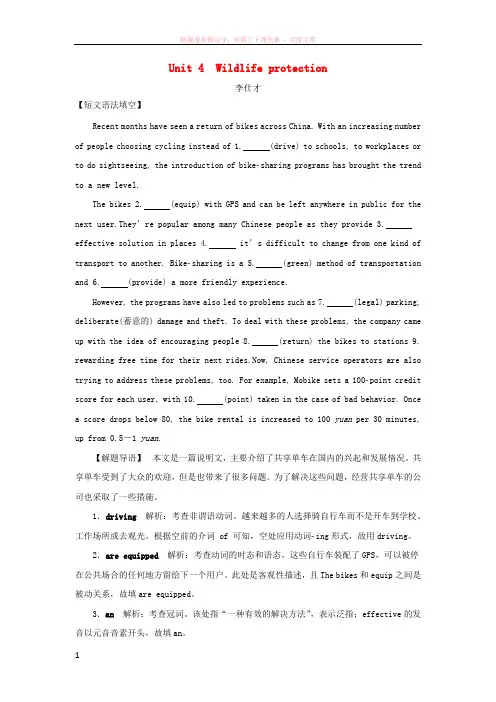
Unit 4 Wildlife protection李仕才【短文语法填空】Recent months have seen a return of bikes across China. With an increasing numberof people choosing cycling instead of 1. (drive) to schools, to workplaces orto do sightseeing, the introduction of bikesharing programs has brought the trendto a new level.The bikes 2. (equip) with GPS and can be left anywhere in public for thenext user.They’re popular among many Chinese people as they provide 3.effective solution in places 4. it’s difficult to change from one kind of transport to another. Bikesharing is a 5. (green) method of transportationand 6. (provide) a more friendly experience.However, the programs have also led to problems such as 7. (legal) parking, deliberate(蓄意的) damage and theft. To deal with these problems, the company cameup with the idea of encouraging people 8. (return) the bikes to stations 9. rewarding free time for their next rides.Now, Chinese service operators are alsotrying to address these problems, too. For example, Mobike sets a 100point creditscore for each user, with 10. (point) taken in the case of bad behavior. Oncea score drops below 80, the bike rental is increased to 100 yuan per 30 minutes,up from 0.5-1 yuan.【解题导语】本文是一篇说明文,主要介绍了共享单车在国内的兴起和发展情况。
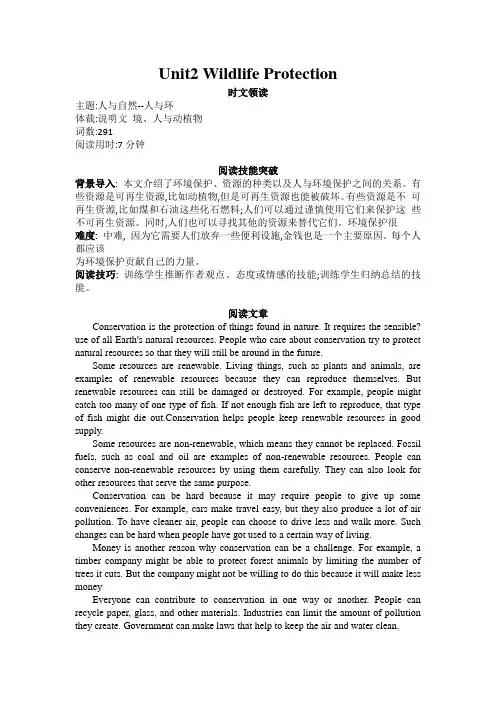
Unit2 Wildlife Protection时文领读主题:人与自然--人与环体裁:说明文境、人与动植物词数:291阅读用时:7分钟阅读技能突破背景导入: 本文介绍了环境保护、资源的种类以及人与环境保护之间的关系。
有些资源是可再生资源,比如动植物,但是可再生资源也能被破坏。
有些资源是不可再生资源,比如煤和石油这些化石燃料;人们可以通过谨慎使用它们来保护这些不可再生资源。
同时,人们也可以寻找其他的资源来替代它们。
环境保护很难度: 中难, 因为它需要人们放弃一些便利设施,金钱也是一个主要原因。
每个人都应该为环境保护贡献自己的力量。
阅读技巧: 训练学生推断作者观点、态度或情感的技能;训练学生归纳总结的技能。
阅读文章Conservation is the protection of things found in nature. It requires the sensible? use of all Earth's natural resources. People who care about conservation try to protect natural resources so that they will still be around in the future.Some resources are renewable. Living things, such as plants and animals, are examples of renewable resources because they can reproduce themselves. But renewable resources can still be damaged or destroyed. For example, people might catch too many of one type of fish. If not enough fish are left to reproduce, that type of fish might die out.Conservation helps people keep renewable resources in good supply.Some resources are non-renewable, which means they cannot be replaced. Fossil fuels, such as coal and oil are examples of non-renewable resources. People can conserve non-renewable resources by using them carefully. They can also look for other resources that serve the same purpose.Conservation can be hard because it may require people to give up some conveniences. For example, cars make travel easy, but they also produce a lot of air pollution. To have cleaner air, people can choose to drive less and walk more. Such changes can be hard when people have got used to a certain way of living.Money is another reason why conservation can be a challenge. For example, a timber company might be able to protect forest animals by limiting the number of trees it cuts. But the company might not be willing to do this because it will make less moneyEveryone can contribute to conservation in one way or another. People can recycle paper, glass, and other materials. Industries can limit the amount of pollution they create. Government can make laws that help to keep the air and water clean.生词积累:① conservation n.保护② sensible adj. 明智的;合理的③ non-renewable adj. 不可再生的④ recycle v. 回收利用拓展阅读[课标全国【2017·B篇]1 work with V olunteers for Wildlife, a rescue and education organization at Bailey Arboretum in Locust Valley. Trying to help injured displaced or sick creatures can be heartbreaking; survival is never certain. However, when it works, it is, simply beautiful.I got a rescue call from a woman in Muttontown.She had found a young owl(猫头鹰)on the ground.When ! arrived,I saw a 2- to 3-week-old owl. It had already been placed in a carrier for safety.I examined the chick(雏鸟)and it seemed fine.If 1 could locate the nest, I might have been able to put it back, but no luck. My next work was to construct a nest and anchor it in a tree.The homeowner was very helpful. A wire basket was found. I put some pine branches into the basket to make this nest safe and comfortable. I placed the chick in the nest, and it quickly calmed down.Now all that was needed were the parents, but they were absent. I gave the homeowner a recording of the hunger screams of owl chicks. These advertise the presence of chicks to adults ; they might also encourage our chick to start calling as well. I gave the owner as much information as possible and headed home to see what news the night might bringA nervous night to be sure, but sometimes the spirits of nature smile on us all! The homeowner called to say that the parents had responded to the recordings. I drove over and saw the chick in the nest looking healthy and active. And it was accompanied in the nest by the greatest sight of all- LUNCH! The parents had done their duty and would probably continue to do so.1. What is unavoidable in the author's rescue work according to Paragraph 1?A. Efforts made in vain.B. Getting injured in his workC. Feeling uncertain about his futureD. Creatures forced out of their homes2. Why was the author called to Muttontown?A. To rescue a woman.B. To take care of a woman.C. To look at a baby owl.D.To cure a young owl.3. What made the chick calm down?A. A new nest.B. Some food.C.A recording.D.Its parents.4. How would the author feel about the outcome of the event?A. It's unexpected.B.It's beautiful.C. It's humorous.D. It's discouraging.答案:ACAB。
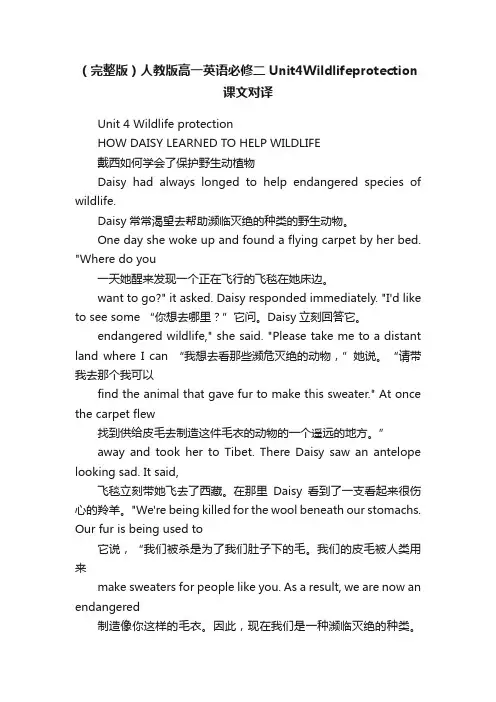
(完整版)人教版高一英语必修二Unit4Wildlifeprotection课文对译Unit 4 Wildlife protectionHOW DAISY LEARNED TO HELP WILDLIFE戴西如何学会了保护野生动植物Daisy had always longed to help endangered species of wildlife.Daisy常常渴望去帮助濒临灭绝的种类的野生动物。
One day she woke up and found a flying carpet by her bed. "Where do you一天她醒来发现一个正在飞行的飞毯在她床边。
want to go?" it asked. Daisy responded immediately. "I'd like to see some “你想去哪里?”它问。
Daisy立刻回答它。
endangered wildlife," she said. "Please take me to a distant land where I can “我想去看那些濒危灭绝的动物,”她说。
“请带我去那个我可以find the animal that gave fur to make this sweater." At once the carpet flew找到供给皮毛去制造这件毛衣的动物的一个遥远的地方。
”away and took her to Tibet. There Daisy saw an antelope looking sad. It said,飞毯立刻带她飞去了西藏。
在那里Daisy看到了一支看起来很伤心的羚羊。
"We're being killed for the wool beneath our stomachs. Our fur is being used to它说,“我们被杀是为了我们肚子下的毛。
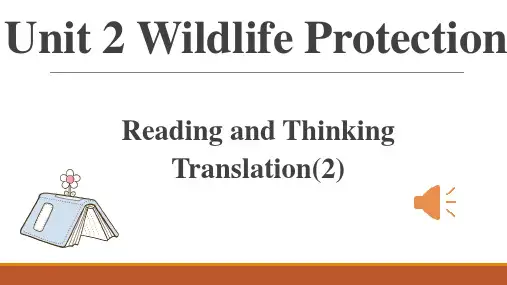
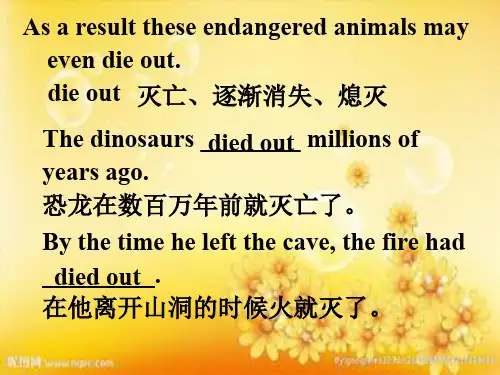
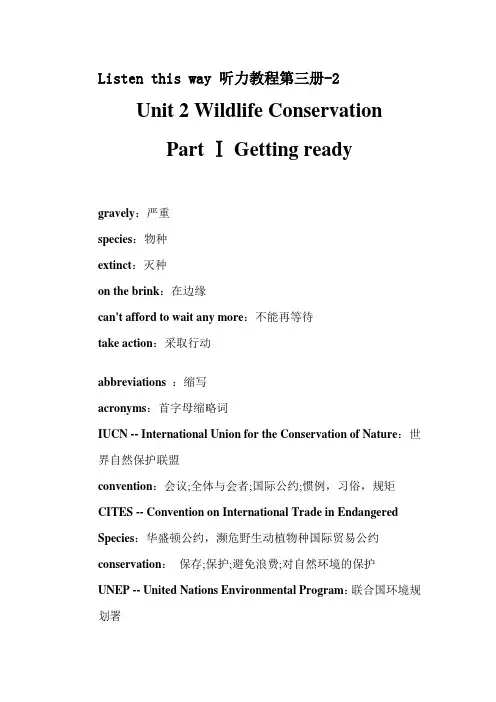
Listen this way 听力教程第三册-2Unit 2 Wildlife ConservationPart Ⅰ Getting readygravely:严重species:物种extinct:灭种on the brink:在边缘can't afford to wait any more:不能再等待take action:采取行动abbreviations :缩写acronyms:首字母缩略词IUCN -- International Union for the Conservation of Nature:世界自然保护联盟convention:会议;全体与会者;国际公约;惯例,习俗,规矩CITES -- Convention on International Trade in Endangered Species:华盛顿公约,濒危野生动植物种国际贸易公约conservation:保存;保护;避免浪费;对自然环境的保护UNEP -- United Nations Environmental Program:联合国环境规划署WWF -- World Wide Fund for Nature :世界自然基金会regulate:调节;控制,管理promote the conservation:促进保护under the auspices of:在…的帮助或支持下;有…赞助的prohibit:禁止endangered species:濒危野生动植物种encourage partnerships in doing sth:鼓励伙伴partnership:伙伴关系;合伙人身份;合作关系;合营公司inspiring information:鼓舞人心的信息improve their quality of life:改善生活品质without compromising:不妥协enable sb to do sth:使……能raise funds for :筹款giant panda:大熊猫a global network:全球网Gland:格兰德Switzerland:瑞士biological diversity:生物多样性ecosystem services:生态系统服务variety:种类a breathable atmosphere:洁净的(能够呼吸的)空气reduce in number :数量减少role:任务negligible:以忽略的;微不足道的apes:猿whales:鲸seals:海豹marine turtles:海龟walrus:海象dolphins:海豚crocodiles:鳄鱼bludgeon:攻击;威胁,强迫campaign:运动sanctuaries:庇护所sea sanctuary:海洋保护区protected-nesting sites :受保护的营巢区nesting site:营巢区;筑巢区;巢址pollute:污染ivory:象牙porpoise:动鼠海豚come into force:开始生效habitat:(动物的)栖息地,住处compromise:妥协roll off:辗轧;下降breed:繁殖public appeal:公众诉求;呼吁slaughter:屠宰(动物);大屠杀make a donation:捐款Wild animals and wild plants and the wild places where they live are gravely threatened almost everywhere. One species has become extinct in each year of this century; and many hundreds are now on the brink. We can't afford to wait any more. It is time that we take action.A The following words and phrases will appear in this unit. Listen carefully and study the definitions.1. habitat: the natural home of a planet or animal2. species: a group of plants or animals of the same kind, which are alike in all important ways and can breed together3. bludgeon: hit with a heavy object4. census: a count of a total population5. logistics: the planning and implementation of the details of any operation6. degrade: bring down7. adversely: in the manner of going against, opposing8. refuge: a place that provides protection or shelter from danger9. aquatic: living in or on water10. mussel: a small sea animal living inside a black shell whose soft body can be eaten as food (淡菜)11. staple food: basic food or main food that one normally eats12. picky eater: someone who is very careful about choosing only what they like to eat13. shrink: to become or cause to become smaller in size14. case study: a detailed analytical study of a person or something with a view to making generalizationsB Listen to some abbreviations and acronyms of some organizations and some information about them. Fill in the blanks.Audioscript:1. IUCN -- International Union for the Conservation of Nature, is the organization established by the United Nations to promote the conservation of wildlife and habitats as part of the national policies of member states.2. CITES -- Convention on International Trade in Endangered Species. is an international agreement under the auspices of the IUCN with the aim of regulating trade in endangered species of animals and plants. The agreement came into force in 1975 and by 1991 had been signed by 110 states. It prohibits any trade in a category of 8,000 highly endangered species and controls trade in a further 30,000 species.3. UNEP -- United Nations Environmental Program, aims to provide leadershi p and encourage partnerships in caring for the environment by inspiring information and enabling nations and people to improve their quality of life without compromising that of future generations.4. WWF -- World Wide Fund for Nature (formerly World Wildlife Fund), is an international organization established in 1961 to raise funds for conservation by public appeal. Projects include conservation of particular species, for example, the tiger and giant panda. With almost five million supporters distributed throughoutfive continents, WWF has a global network active in over 90 countries. Its headquarters are in Gland, Switzerland.Biological diversity provides us with a variety of special "ecosystem services", such as clean water, a breathable atmosphere and natural climate control. However, many kinds of wild animals have been so reduced in number that their role in the ecosystem is negligible. Animals like the great apes, the whales, seals, and marine turtles are under particular pressure.C Listen to the conversation. Match column A, which is alist of the names of some endangered animals, with column B, which gives the information about those endangeredanimals. Then anwser the questions.Questions:1. What do people at the World Wildlife Fund work for according to the woman?They work to conserve natural areas that contain endangered wildlife.2. What are they doing in order to protect those endangered animals? They are campaigning to provide sea sanctuaries for some of these endangered species. Protected-nesting sites for turtles have been set up.3. Can you guess the meaning of "sea sanctuaries"?It refers to the places of safety in the sea where sea animals are protected and allowed to live freely.Audioscript:A: Hello, I'm calling on behalf of the World Wildlife Fund.B: The what?A: The World Wildlife Fund. If you've got a few minutes I'd like to tell you what that means.B: Oh, all right.A: We work to conserve natural areas that contain endangered wildlife. The seas, for example, have become polluted by the industrialized world; whales are being hunted to extinction;turtles are rolled off their eggs when they come ashore to breed or are slaughtered for their meat and oil...B: Oh.A: Crocodiles are killed to make handbags and shoes; walruses are hunted for their ivory.B: I see.A: Seals are bludgeoned to death to provide fur coats and the threat of extinction hangs over several species of whale, dolphin and porpoise.B: Really.A: We are now campaigning to provide sea sanctuaries for some of these endangered species.B: Very interesting.A: Aided by our campaign, protected nesting sites for turtles have already been set up. As you can see, this is very valuable work and I wonder therefore if you'd like to make a donation?Part II Christmas bird countsbe deemed:(被)认为,视为,断定fortunes :命运critically:危急;严重perilous:危险的,冒险的at risk of :有……危险imminent extinction:即将灭绝lose a species:丧失一个物种residents:居民maintaining:保持sustain:维持;支撑;忍受quality:质量sustaining the quality of lives :维持生活质量John James Audubon :约翰·詹姆斯·奥杜邦,1785年4月26日-1851年1月27日),美国画家、博物学家,他绘制的鸟类图鉴被称作“美国国宝”illustrate:说明;描绘;画插图in their natural habitats:自然居住地conservationist:自然资源保护者,生态环境保护者feather:羽毛,翎毛manufacture:制造sponsored by :赞助;发起the National Audubon Society:全国奥杜邦(鸟类保护)协会Bermuda:百慕大群岛(北大西洋西部群岛)Pacific islands:太平洋岛屿volunteer:志愿者bird count:鸟类的清点experienced:有经验的bird watcher:野鸟观察者,鸟类观察家diameter:直径observe:观察actually :实际上,实质上,事实上,几乎longest-running:播放时间最长的census:人口普查,统计;人口财产调查ornithology:鸟类学;鸟学scheduled:排定,进度表logistics:组织工作ideal:理想;目标virtually:实际上,实质上,事实上,几乎identify :识别,认出Panama:巴拿马esthetic value:审美价值indicator:指示器habitat alteration:栖息地变更signal:信号,暗号;预兆,征象degrade:降低,贬低;使降级degradation:退化;堕落;降级adversely:反对;不利地;有害地annual:每年Christmas bird counts:对诞(岛)数鸟decline:下降One in eight of the world's bird species is deemed globally threatened and the fortunes of 198 critically endangered species are now so perilous that they are at risk of imminent extinction. Many people feel that every time we lose a species, the world becomes a poorer place. The more successful we are at maintaining or improving the living conditions of the Earth'smany residents, the better our chances will be of sustaining the quality of all species' lives on Earth.A Listen to a news report. While listening for the first time, add more key words in the notes column according to the following cues. While listening for the second time, supply the missing information.Event: Christmas bird countsTime: from Christmas to Jan. 3rdSponsored by: the National Audubon SocietyParticipants:Numbers:more than 40,000 volunteersBackground: from all 50 states of the U.S., every Canadianprovince, parts of Central and SouthAmerica', Bermuda, the West Indiesand Pacific islandsNumber of bird counts this year: more than 1 600 separate bird countsThe logistics of bird counts: Each individual count is in a 15 mile diameter circle around the exact center point.Origin of the National Audubon Society: It was named after an American artist John James Audubon, who illustrated birds in their natural habitats. The Society was founded in the late1800s by conservationists concerned with the decline of birds.B Now try this: listen to a more authentic version of the report. Complete the summary of this year's Christmas bird counts.Christmas bird counts will start from Christmas to January 3rd., sponsored by the National Audubon Society. This year more than 40 000 volunteers from the U.S., Canada, parts of Central and South America, Bermuda, the West Indies and Pacific islands will be outside counting birds. The counts are not only for experienced bird watchers but anyone that is interested or concerned as well.This year more than 1 600 separate bird counts have been scheduled. Some would have as few as 10 people taking part, others with hundreds. Every individual count is in a 15 mile diameter circle around the exact center point. Bird counters can get a good idea of the total bird populations within the count circle based on t he number of birds they actually see.The traditional Christmas bird count is the longest-running bird census in ornithology.Audioscript:John James Audubon was an American artist in the early 1800s, who illustrated birds in their natural habitats. The Society named after him was founded in the late 1800s by conservationists concerned with the decline of birds, which were being killed so their feathers could be used in the manufacture of women's hats.Sponsored by the National Audubon Society, more than 40 000 volunteers will be outside counting birds from today until January3rd. Volunteers from all 50 states of the United States, every Canadian province, parts of Central and South America, Bermuda, the West Indies and Pacific islands have begun to count and record every individual bird and bird species observed during the two and one half week period of the count.Jeffrey LeBaron is the National Audubon Society's Christmas Bird Count editor. He says the count is the longest-running bird census in ornithology.This year, according to Mr. LeBaron , more than 1 600 separate bird counts have been scheduled. Some would have as few as 10people taking part, others with hundreds. The logistics of the Christmas bird count, he adds, are simple."Each individual count is in a circle. It's a 15 mile diameter circle, um, around the exact center point. And it's always the exactly same area that's done every year, usually, even on the same weekend during the count period. And what the ideal would be, which is virtually impossible, is this census: every single individual bird within that circle on the count day."Mr. LeBaron says experienced bird counters can get a good idea of the total bird populations within the count circle based on the number of birds they actually see. The editor points out, however, that the counts are not only for experienced bird watchers."Anybody that is interested or concerned can become involved. Beginners will go out in a party with experienced individuals who know both the area and the birds in the area, in the field where more eyes and ears are better. And then anybody can point out a bird, and someone in the field will always be able to identify the bird."C Now listen to what Mr. Lebaron says about the information concerning birds. Complete the outline.OutlineI. Total number of known species -- about 9 300II. HabitatA. Larger numbers living in the warmer climatese.g. more than 300 different species counted in PanamaB. far fewer species native to colder climatesIII. ValueA. importance to the environment1. indicator of the quality of environment2. sensitive to habitat alterationB. esthetic value1. getting pleasure out of looking at birds andlistening to birds2. mental quality of life degraded without birds IV. Birds' populationA. some species -- decliningB. many types -- increasingAudioscript:Mr. LeBaron says there are about 9 300 different known species of birds. Larger numbers of them live in the warmer climates. For example, more than 300 different species have been counted in Panama, while far fewer species are native to colder climates. Aside from their esthetic value, Mr. LeBaron says birds are important to the environment because they can signal changes in it."Birds are one of the best indicators that we have of the quality of the environment within the given area. Whether it is a relatively local area, or even primarily on the worldwide bases, they are one of the first things to be altered. They are quite sensitive to a habitat alteration or to other threats. And often times when birds are disappearing out of the area, it just means there is a degradation of the quality of the habitat within that area which will adversely affect everything in there including humans."National Audubon Society editor Jeffrey LeBaron calls the world's bird populations a source of wealth that humans must protect. "People get so much pleasure out of looking at birds and listening to birds. And if they start disappearing just the er, the quality of life,um, may be not physically, but the mental quality of life can be degraded quickly."Jeffrey LeBaron says that while the National Audubon Society's annual Christmas bird counts show a decline in some species, many types of birds are actually increasing their populations.Part III Dolphin captivityin captivity:养在笼子(或池子,等)里;囚禁announcer:播音员thesis statements:文意,简述论文,论文主题Colorado Public Radio:科罗拉多州公共广播电台aquatic park:水上公园Denver:丹佛(美国科罗拉多州)ire:愤怒dolphin :海豚instigate:教唆;煽动;激起a former navy dolphin trainer :前海军海豚训练员Florida:佛罗里达州ranges:范围family-oriented:面向家庭的;群居的concrete tank:混凝土水箱,混凝土油罐,混凝土贮水池sonar:声呐装置bounce off:试探(某人对某一新设想和意见),大发议论ocean explorer:海洋探险家reject:拒绝;抛弃suicidal:自杀的,自杀性的;自我毁灭的,自取灭亡的;于己不利pool :池子a very sophisticated brain:发达的大脑sophisticated:复杂的;精致的;富有经验的;深奥微妙的Portland:波特兰(俄勒冈州)Oregon.:俄勒冈州captive dolphins :被捕的海豚Sarasota Bay:萨拉索塔湾(佛罗里达州)Florida:佛罗里达州the census data :统计数据distribution:分配,分布debate:讨论;辩论;争论marine mammal:海洋哺乳动物organisms:有机体;生物operate:操作,运行metabolically:代谢的anti-educational:对抗教育,反教育,逆教育natural behavior :自然行为alter:改变;更改stranded:处于困境的beach:海滩fractured ribs or jaws:头骨、肋骨、下颌骨骨折pros:同意,支持cons:反对We have learned a great deal by observing the animals kept in the zoo. However, wildlife is wild. Do you think we are protecting them or making them suffer by keeping them in captivity?A The following words are used in the news interview. Listen to the words first. Study the definitions carefully.1. ire: anger2. instigate: provoke to some action3. sonar: a method for finding and locating objects under water by means of the sound waves they reflect or produce4. bounce (off): (sound or light) reach the surface and is reflected back5. marine: of, near or living in the sea6. breed: produce offspring7. metabolically: pertaining to what is needed to function8. alter: change9. stranded: left abandonedB Listen to the news interview. There are five persons in it.Match column A with column B to indicate who's who.Then write out the thesis statements they are arguing about.Thesis Statement No. 1:Dolphins should be kept in captivity.Thesis Statement No. 2:There are educational benefits of keeping marine mammals in captivity.C Now try this: listen to a more authentic version of theinterview. Write out each person's pros (agree with thethesis) or cons (disagree with the thesis) for each thesisstatement in note form.Audioscript:[Alan Tu is an announcer for Colorado Public Radio; Peter Jones is a reporter for Colorado Public Radio. The other speakers are identified in the report.]A: A planned aquatic park in Denver is raising the ire of animal rights activists who object to a proposal to include a captivedolphin display. Although officials for Colorado's OceanJourneys say they have yet to make a final decision on the issue, local and national activists have already instigated a "NoDolphins in Denver" campaign. As Colorado Public Radio'sPeter Jones reports, the battle lines have been clearly drawn. P:Rick Troud, a former navy dolphin trainer based in Florida, is taking an active role in the "No Dolphins" campaign.R:Average age in the wild ranges anywhere in some of the studies between 30 and 40 years of age. In captivity, you can expect adolphin to live maybe 5.13 years, and every 7 years in captivity the dolphin population is dead.P:According to Troud, there are many reasons why dolphins can't live full lives in captivity.R:If you take a look at where the real dolphin is in the real ocean, you find the dolphin who swims 40 miles a day, is veryfamily-oriented. These animals are separated from theirmothers; that's a stress. You put them in a concrete tank where their sonar bounces off the walls, they can't swim in the sameamount of time and direction that they can in the wild.P:Environmentalist and ocean explorer, Jean Michel Cousteau:J: There are some animals which reject captivity right away, and they're very suicidal. I've had one of those in my own arms for many days. The next morning when I came to take care of him, he was dead. And what he'd done was to swim as fast as hecould from one end of the pool on ... to the other side anddestroyed his head by hitting the wall. They have a verysophisticated brain. I don't think we have any rights to playwith the lives of these animals.P:Cousteau's anti-captivity position is challenged by Dr. Deborah Duffield, a biology professor at Portland State College inOregon. Her 1990 study compared captive dolphins to the wild population of Sarasota Bay, Florida. Among other findings, the study showed little if any difference in the average age of death.And Duffield says life is generally getting better for captivedolphins.D: The census data say that every time I do a census, I've got older and older animals in it as well as this normal age distribution that we've been looking at. So my feeling is that the trend incaptivity has been that the group of animals that we'refollowing are getting older, and if they continue to do that over the next five years, they will then indeed be older than the wild population.P:There is also a debate over the educational benefits of keeping marine mammals in captivity. According to Duffield, captive dolphins play an important role in our basic understanding of the animals.D: I firmly believe that we cannot learn anything about organisms that we share this world with if we do not understand how they live in an environment, and what they do, and that watchingthem go by in the wild will not do it. I cannot tell what ananimal needs, unless I know how it operates, how it breeds,what it needs metabolically, and I can't learn that from animals in the wild.P:But Troud says the dolphin displays are anti-educational because the animals' natural behavior patterns are altered by captivity.R:In the wild, you don't have dolphins who beat each other to death.There are no dolphins that I've ever seen stranded on the beach, who are suffering from fractured skulls, fractured ribs orfractured jaws, as is the case in captivity.P:The Ocean Journey board will take all factors into consideration before making a final decision on whether to include dolphinsin the park. For Colorado Public Radio, I'm Peter Jones.Part IV More about the topic:Wildlife in dangera profound effect:深远的影响ecosystems:生态系统upsetting:倾复unclear:不清楚adapt enough to:适应得够adapt to:使适应于,能应付survive:活命mountain:山forest:林giant panda:大熊猫roughly:大约bamboo:竹子staple food:主食Michigan State University:密歇根州立大学a dramatic impact:巨大影响the long-term solution:长期的解决方案long-term:长期的;长远heat-resistant:耐热的,抗热的notoriously:恶名昭彰地;声名狼藉地picky eater:好挑食shrink:收缩,皱缩;(使)缩水;退缩,畏缩shrinking fish:水温高鱼变小consequence:结果metabolic:新陈代谢的metabolic rates:代谢率oxygen:氧气stay alive:活着predict:预言,预测kill off:消灭,一个接一个地杀死projection:预测;规划,设计relatively:关系上地;相对地;比较calculate:计算;估计;打算,计划;旨在case study:个案研究;专题;研究实例;范例分析unexpectedly:未料到地,意外地;竟;居然;骤然North Atlantic cod:北大西洋鳕鱼underestimate:低估haddock:小口鳕,黑线鳕Climate change is having a profound effect on ecosystems around the world, upsetting and altering the lives of numerous species of animals. As temperatures continue to rise, it's unclear whether all species will be able to adapt enough to survive, especially as other species in their ecosystems adapt by getting smaller or larger.A In the following report, you will learn some facts about the giant panda, an endangered species in China. Listen carefully and supply the missing information.There are roughly 1 600 pandas living in the wild, mainly in the mountain forests of western China. Bamboo is their staple food. And they eat up to 38 kg a day. But some species of the plant take many years to grow, which means they don't adapt to climate change. Scientists are now predicting that an increasing temperature of even 2°C will kill off the species the pandas need to survive. One of the study's authors is Professor Jack Lu of Michigan State University."Even by the middle of the century, this century, the impact will be very obvious. And by the end of the century, in many areas, 100 percent of this bamboo will be gone. And that's really a dramatic impact that people have not realized". Reducing global warming is the long-term solution and creating new panda habitats is another. It may also be possible to introduce new species of bamboo that are heat-resistant. But unfortunately, pandas are notoriously picky eaters and may reject even a slight change to their diet. Audioscript:There are roughly 1 600 pandas living in the wild, mainly in the mountain forests of western China. Bamboo is their staple food. And they eat up to 38 kg a day. But some species of the plant take many years to grow, which means they don't adapt to climate change. Scientists are now predicting that an increasing temperature of even 2°C will kill off the species the pandas need to survive. One of the study's authors is Professor Jack Lu of Michigan State University. "Even by the middle of the century, this century, the impact will be very obvious. And by the end of the century, in many areas, 100 percent of this bamboo will be gone. And that's really a dramatic impact that people haven not realized". Reducing global warming is the long-term solution and creating new panda habitats is another. Itmay also be possible to introduce new species of bamboo that are heat-resistant. But unfortunately, pandas are notoriously picky eaters and may reject even a slight change to their diet.B The following report is about shrinking fish found in thesea as a consequence of global warming. While listening for the first time, note down as many key words as you can inthe left-hand column. After the second listening, fill in thegaps in the summary in the right-hand column with the help of the notes.Audioscript:Although projections of global temperature rises show relatively small changes at the bottom of the oceans, the resulting impacts on fish body size are "unexpectedly large", according to this research. As ocean temperatures increase, so do the body temperatures and metabolic rates of the fish. This means they use more oxygen to stay alive and, according to the researchers, they have less avalilable for growth.They've calculated that up to 2050, fish will shrink in size by between 14 and 24 percent, with the Indian and Atlantic Oceans worst affected. The warming waters are also likely to drive fish more towards the poles, leading to smaller species living in areas like the North Sea.According to the scientists, their models may underestimate the potential impacts. When they looked at case studies involving North Atlantic cod and haddock, they found that recorded data on these fish showed greater decreases in actual body size than the models predicted.Part V Do you know ...?catalog:目录,目录册,目录簿inhabit v.:居住the planet:这个行星(地球)estimate:估计,预测;报价,exceeding:胜过in the form of parks:在公园的形式下wildlife refuge:野生动物保护区reserve:保护区,保存,储备aquatic animal:水生动物crayfish:淡水螯虾(肉);龙虾mussel:贻贝,蚌类;淡菜In general, an endangered species is one that's in immediate danger of becoming extinct. Its numbers are usually low, and it needs protection in order to survive.Listen to some facts about endangered species. Pay special attention to the numbers.Audioscript:● Scientists hav e cataloged more than one and one-half million ofthe species that exist on Earth today. By some recent estimates, at least 20 times that many species inhabit the planet.● Up to 100 species become extinct every day. Scientists estimatethat the total number of species lost each year may climb to40,000 by the year 2000, a rate far exceeding any in the last 65 million years.● Around the world more than 3 500 protected areas exist in theform of parks, wildlife refuges and other reserves. These areas cover a total of about 2 million square miles (5 million square km, or 3% of our total land area).● Today, more than 200 animal species in the United States areclassified as endangered. More than 1,000 animal species areendangered worldwide.● Little-noticed aquatic animals are in big trouble. In North America,a third of our fish species, two-thirds of our crayfish speciesand nearly three-quarters of the mussel species are in trouble. Part VI Reminder of key points inthis unitPart VII Watch and enjoyYou're going to watch a video clip taken from Saving Species, a program by National Geographic Society. Watch carefully and decide whether the following statements are True or False. Write "T" or "F" for each statement.endangered species.creatures.plants and animals in immediate danger of extinction.endangered species in the America.of a biological catastohpe.depend utterly on other creatures for our very survival and therefore they're our companions in the biosphere.Videoscript::The first Europeans on this continent had a common enemy to conquer. It was called nature. America seemed to be an endless expanse of hostile wilderness. Bison wandered along the Potomac. Grizzly bears strolled the beaches of California. Human beings did not even know it was possible for a species to go extinct, but we。
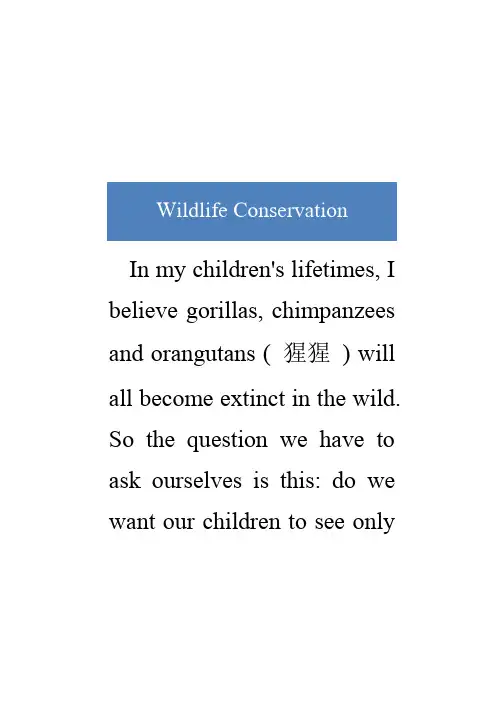
In my children's lifetimes, I believe gorillas, chimpanzees and orangutans ( 猩猩) will all become extinct in the wild. So the question we have to ask ourselves is this: do we want our children to see onlyin zoos what used to exist in the real world? It is the great apes that will disappear first, because there are so few of them left, and because they're so vulnerable to changes in their habitats.Many of the threats to these animals result from aglobal economy and not local pressures. The threat to the orangutans in Indonesia, for example, is largely a result of deforestation and the risks to apes and chimpanzees in Africa result from the timber trade and the demand for bush-meat. The two worktogether: logging opens up the forest, which means that the bush-meat can be got out fast, to Kinshasa or to London.If we want to avoid the disaster, people in developed countries will have to take a global perspective and acceptresponsibility for the damage export crops, such as timber, coffee, cut flowers or even green beans, do to the environment. The challenge is to avoid simply imposing Western attitudes on local peoples.Already there are no truly wild places left in the world. Looking at wildlife has become the preserve of the middle classes over the last 20-odd years, and as wild animals become even rarer, so more tourists want to see them. But tourism aloneplainly cannot conserve the world's animals; economic development is the priority. For the future, I suspect that if you really want to do something about wildlife conservation, you would be better off putting your money into women's educationrather than just into the protection of flagship species. Women often bear the direct costs of wildlife conflict; their knowledge of how to deal with conflict and how to control their own reproductive destinies mayyet determine the survival of many threatened species. Choose the best answersto the following questions. 1.Why will the great apesbecome extinct inthe wild first?A.Because the great apes are moving away from the wild life conservation areas.B.Because the great apes are unable to survive any natural disasters.C.Because more and more great apes are kept in zoos.D.Because the great apes are unadaptable to changes in the environment.2.In the second paragraph, the word "deforestation" means.A.the process of hunting for wildlife in forestsB.adventures in forestsC.the process of removing forests from a placeD.the exploration of forests3. According to the passage, all of thefollowing statements are true except_________A.the development of tourism helps to conserve the wildlifeB.developed countries should be aware of the damage export crops do to the environmentC.all the threats to animals result from local pressures aloneD.the timber trade and the demand for bush-meat risk the lives of primates in Africa4. We can infer from the fourth paragraph thatA.it is the m iddle classthat should take moreresponsibility foranimal conservationpared with economic development, tourism is more important in animal conservationC.in order to conserve wild animals, economicdevelopment should be put above everything elseD.tourism cannot conserve the wildlife; it will only do harm to the environment5. The author suggests in the last paragraph that .A.one would be richer if he puts money into women's educationB.to put money into women's education is moreimportant in wildlife conservation than to put money into flagship species orotectionC.women know how to determine the survival of many threatened speciesD.worn en often bear the direct costs of wildlife conflictComplete the following sentences with the information given in the passage.1. According to the author, the extinction of wild animalswill be mainly a resultof____.KEY:the global economy 2.Not only local people, but also___ should be responsible for the damageexport crops do to the environment.KEY:people in developed countries3.More and more t ourists want to see wild animals because____KEY: wild animals are becoming rarer翻译野生动物保护在孩子们的一生中,我相信大猩猩,黑猩猩和猩猩(猩猩)都将成为在野外绝迹。
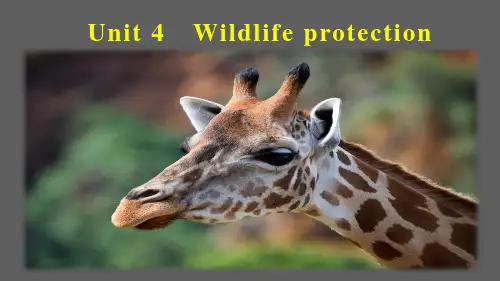
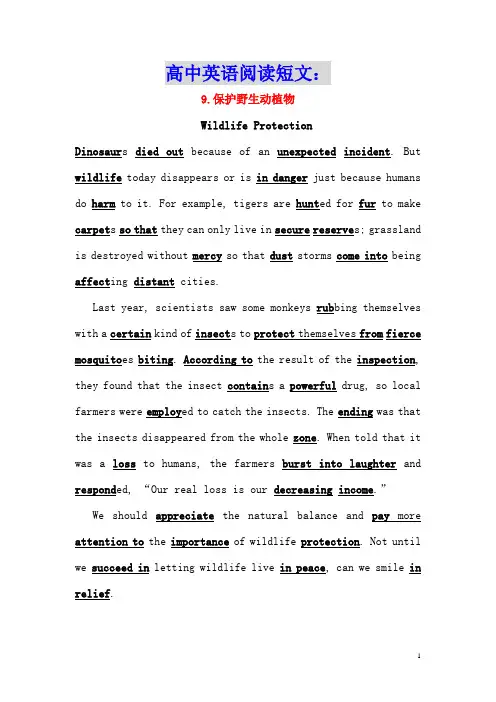
高中英语阅读短文:9.保护野生动植物Wildlife ProtectionDinosaur s died out because of an unexpected incident. But wildlife today disappears or is in danger just because humans do harm to it. For example, tigers are hunt ed for fur to make carpet s so that they can only live in secure reserve s; grassland is destroyed without mercy so that dust storms come into being affect ing distant cities.Last year, scientists saw some monkeys rub bing themselves with a certain kind of insect s to protect themselves from fierce mosquito es biting. According to the result of the inspection, they found that the insect contain s a powerful drug, so local farmers were employ ed to catch the insects. The ending was that the insects disappeared from the whole zone. When told that it was a loss to humans, the farmers burst into laughter and respond ed, “Our real loss is our decreasing income.”We should appreciate the natural balance and pay more attention to the importance of wildlife protection. Not until we succeed in letting wildlife live in peace, can we smile in relief.恐龙因一次意外事件而灭绝,但是今天的野生动植物却是因为人类的伤害而消失或处在危险中。
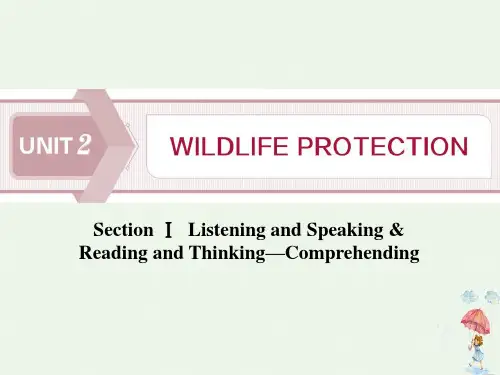
必修第二册Unit 2 Wildlife protection Reading and Thinkinghunt vt.& vi.打猎;搜寻;追捕hunter n.猎人(经典佳句)Mary has been hunting for a job since she graduated from college.自从大学毕业,玛丽一直在找工作。
hunt for寻找某人/某物go hunting 去打猎①Weather permitting, we’ll go hunting this Sunday morning.如果天气允许,我们这周日上午要去打猎。
②We set up a wildlife reserve to protect animals from being hunted.我们设立了一个野生动物保护区,保护动物免受猎杀。
③They are still hunting the missing boy, who disappeared last Sunday after attending his friend’s birthday party.die out灭亡;逐渐消失(教材P14)Our planet’s species is dying out at an alarming rate.我们星球上的物种正以惊人的速度灭绝。
die of因…而死(疾病、饥饿、情感原因等) die from因…而死(外伤、车祸、污染等)die away(声音、风、光等)渐渐消失die down(兴奋、火等)渐弱,渐息①As is known to us, many people in African countries hunger every year.②The sound of the engine as the car drove into the distance.③Many old customs have died out because they are out of date.aware adj.知道;发觉;有……意识的(经典佳句)We should be aware of the importance of protecting the environment.我们应该意识到保护环境的重要性。
In my children's lifetimes, I believe gorillas, chimpanzees and orangutans ( 猩猩) will all become extinct in the wild. So the question we have to ask ourselves is this: do we want our children to see onlyin zoos what used to exist in the real world? It is the great apes that will disappear first, because there are so few of them left, and because they're so vulnerable to changes in their habitats.Many of the threats to these animals result from aglobal economy and not local pressures. The threat to the orangutans in Indonesia, for example, is largely a result of deforestation and the risks to apes and chimpanzees in Africa result from the timber trade and the demand for bush-meat. The two worktogether: logging opens up the forest, which means that the bush-meat can be got out fast, to Kinshasa or to London.If we want to avoid the disaster, people in developed countries will have to take a global perspective and acceptresponsibility for the damage export crops, such as timber, coffee, cut flowers or even green beans, do to the environment. The challenge is to avoid simply imposing Western attitudes on local peoples.Already there are no truly wild places left in the world. Looking at wildlife has become the preserve of the middle classes over the last 20-odd years, and as wild animals become even rarer, so more tourists want to see them. But tourism aloneplainly cannot conserve the world's animals; economic development is the priority. For the future, I suspect that if you really want to do something about wildlife conservation, you would be better off putting your money into women's educationrather than just into the protection of flagship species. Women often bear the direct costs of wildlife conflict; their knowledge of how to deal with conflict and how to control their own reproductive destinies mayyet determine the survival of many threatened species. Choose the best answersto the following questions. 1.Why will the great apesbecome extinct inthe wild first?A.Because the great apes are moving away from the wild life conservation areas.B.Because the great apes are unable to survive any natural disasters.C.Because more and more great apes are kept in zoos.D.Because the great apes are unadaptable to changes in the environment.2.In the second paragraph, the word "deforestation" means.A.the process of hunting for wildlife in forestsB.adventures in forestsC.the process of removing forests from a placeD.the exploration of forests3. According to the passage, all of thefollowing statements are true except_________A.the development of tourism helps to conserve the wildlifeB.developed countries should be aware of the damage export crops do to the environmentC.all the threats to animals result from local pressures aloneD.the timber trade and the demand for bush-meat risk the lives of primates in Africa4. We can infer from the fourth paragraph thatA.it is the m iddle classthat should take moreresponsibility foranimal conservationpared with economic development, tourism is more important in animal conservationC.in order to conserve wild animals, economicdevelopment should be put above everything elseD.tourism cannot conserve the wildlife; it will only do harm to the environment5. The author suggests in the last paragraph that .A.one would be richer if he puts money into women's educationB.to put money into women's education is moreimportant in wildlife conservation than to put money into flagship species orotectionC.women know how to determine the survival of many threatened speciesD.worn en often bear the direct costs of wildlife conflictComplete the following sentences with the information given in the passage.1. According to the author, the extinction of wild animalswill be mainly a resultof____.KEY:the global economy 2.Not only local people, but also___ should be responsible for the damageexport crops do to the environment.KEY:people in developed countries3.More and more t ourists want to see wild animals because____KEY: wild animals are becoming rarer翻译野生动物保护在孩子们的一生中,我相信大猩猩,黑猩猩和猩猩(猩猩)都将成为在野外绝迹。
In my children's lifetimes, I believe gorillas, chimpanzees and orangutans ( 猩猩) will all become extinct in the wild. So the question we have to ask ourselves is this: do wewant our children to see only in zoos what used to exist in the real world? It is the great apes that will disappear first, because there are so few of them left, and because they're so vulnerable to changes in their habitats.Many of the threats to these animals result from a global economy and not local pressures. The threat to the orangutans in Indonesia, for example, is largely a result of deforestation and the risks to apes and chimpanzees in Africa result from the timbertrade and the demand for bush-meat. The two work together: logging opens up the forest, which means that the bush-meat can be got out fast, to Kinshasa or to London.If we want to avoid the disaster, people in developedcountries will have to take a global perspective and accept responsibility for the damage export crops, such as timber, coffee, cut flowers or even green beans, do to the environment. The challenge is to avoid simply imposingWestern attitudes on local peoples.Already there are no truly wild places left in the world. Looking at wildlife has become the preserve of the middle classes over the last 20-odd years, and as wild animals become even rarer,so more tourists want to see them. But tourism alone plainly cannot conserve the world's animals; economic development is the priority. For the future, I suspect that if you really want to do something about wildlife conservation, you would bebetter off putting your money into women's education rather than just into the protection of flagship species. Women often bear the direct costs of wildlife conflict; their knowledge of how to deal with conflict and how to control their ownreproductive destinies may yet determine the survival of many threatened species. Choose the best answersto the following questions.1.Why will the great apesbecome extinct inthe wild first?A.Because the great apes are moving away from the wild life conservation areas.B.Because the great apes are unable to survive any natural disasters.C.Because more and more great apes are kept in zoos.D.Because the great apes are unadaptable to changes in the environment.2.In the second paragraph, the word "deforestation" means .A.the process of hunting for wildlife in forestsB.adventures in forestsC.the process of removing forests from a placeD.the exploration of forests3. According to the passage, all of thefollowing statements are true except _________A.the development of tourism helps to conserve the wildlifeB.developed countries should be aware of the damage export crops do to the environmentC.all the threats to animals result from local pressures aloneD.the timber trade and the demand for bush-meat risk the lives of primates in Africa4. We can infer from the fourth paragraph thatA.it is the m iddle classthat should take moreresponsibility foranimal conservationpared with economic development, tourism is more important in animal conservationC.in order to conserve wild animals, economicdevelopment should be put above everything elseD.tourism cannot conserve the wildlife; it will only do harm to the environment5. The author suggests in the last paragraph that .A.one would be richer if he puts money into women's educationB.to put money into women's education is moreimportant in wildlife conservation than to put money into flagship species orotectionC.women know how to determine the survival of many threatened speciesD.worn en often bear the direct costs of wildlife conflictComplete the following sentences with the information given in the passage.1. According to the author, the extinction of wild animalswill be mainly a resultof____.KEY:the global economy2.Not only local people, but also___ should beresponsible for the damageexport crops do to the environment.KEY:people in developed countries3.More and more t ourists want to see wild animalsbecause____KEY: wild animals are becoming rarer翻译野生动物保护在孩子们的一生中,我相信大猩猩,黑猩猩和猩猩(猩猩)都将成为在野外绝迹。
因此,这个问题我们要问自己的是这样的:我们希望我们的孩子在动物园里看到曾经存在什么在现实世界上唯一?它是将要消失巨猿第一,因为有那么少数人离开了,因为他们是如此脆弱,在它们的栖息地的变化。
许多从全球经济的威胁,这些动物的结果,不是本地的压力。
对在印尼的红毛猩猩的威胁,例如,主要是森林砍伐和风险结果猩猩和非洲的木材贸易的结果对布什和黑猩猩肉的需求。
这两个一起工作:开辟了森林砍伐,这意味着布什肉可以下车快,金沙萨或伦敦。
如果我们要避免灾难的发生,发达国家的人将不得不从全球角度看待和接受的损害出口作物,如木材,咖啡,鲜花甚至绿色豆类,责任,做环境。
目前的挑战是要避免简单地强加给当地人民的西方态度。
已经有没有真正在世界上仅存的野生地。